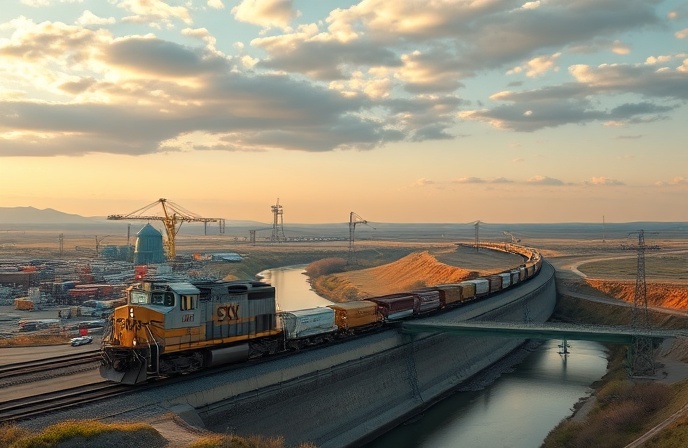Spain’s Rail Upgrade: Zafra-Huelva Line Modernization

Modernizing Spain’s Railway Infrastructure: The Zafra-Huelva Line Upgrade
This article examines the significant €210 million ($228 million) renovation project undertaken by Adif (Administrador de Infraestructuras Ferroviarias), Spain’s national railway infrastructure manager, on the Zafra-Huelva line in southwestern Spain. This comprehensive upgrade focuses on enhancing safety, reliability, and efficiency of the 180km conventional gauge line. The project’s scope extends beyond simple track maintenance, encompassing a complete overhaul of the infrastructure, including track and ballast renewal, bridge reinforcement, and the implementation of advanced signaling and communication systems. This modernization is not just about improving the existing infrastructure but also about laying the foundation for a more sustainable and resilient railway network capable of meeting the demands of future passenger and freight traffic. The project’s financing, partially supported by the European Union’s NextGenerationEU program, underlines the importance of modernizing European rail systems for economic growth and environmental sustainability. The implications of this project extend beyond the immediate improvements to the Zafra-Huelva line, serving as a model for future rail upgrades across Spain and beyond.
Track and Ballast Renewal and Structural Improvements
A key component of the project involves a complete renewal of the track and ballast along the 180km line. This includes the installation of approximately 60km of new rail and concrete sleepers, replacing older, less efficient materials. The use of concrete sleepers offers increased longevity and improved track stability, contributing to smoother train operation and reduced maintenance needs. Furthermore, the project addresses critical drainage issues and reinforces protections against embankment erosion and excavation failures. The project also encompasses the vital structural reinforcement of five bridges located in the Huelva province. This work includes the installation of new waterproofed concrete decks and the reinforcement of bridge foundations for four of these structures, ensuring their long-term stability and safety. The improved drainage system helps prevent water damage to the track bed and bridge structures, improving durability and reducing the frequency of maintenance needs. These are critical to the long-term viability of the railway.
Addressing Operational Challenges and Improving Reliability
The Zafra-Huelva line currently suffers from several speed restrictions across 14 sections due to unstable track conditions. These speed restrictions directly impact train schedules, causing delays and reducing the overall reliability of rail services. The current renovation actively addresses these issues. The 41km section between Calañas and Peguerillas, one of the largest sections undergoing renewal, incorporates the construction of new sidings at two stations, improving train operations and capacity. This section also involves replacing aging wooden sleepers with modern concrete alternatives as part of the comprehensive track renovation. By addressing these weaknesses, the project aims to eliminate or significantly reduce these speed restrictions, leading to faster journey times and more reliable rail services for both passengers and freight transportation.
Advanced Signaling and Communications Systems
The upgrade is not limited to physical infrastructure improvements. Adif is also deploying a GSM-R (Global System for Mobile Communications – Railway) telecommunications system along the Zafra-Huelva Mercancías and Zafra-Llanos de la Granja lines. This modern system allows for direct voice communication between trains and the Centralized Traffic Control (CTC) center, significantly enhancing operational safety and efficiency. The implementation of GSM-R is coupled with the installation of an Automatic Block Signalling on Single Track (ABST) system. Replacing outdated mechanical interlocks with modern electronic alternatives significantly improves signaling reliability, precision, and safety by enhancing the safety and efficiency of train movements.
Conclusion
The €210 million renovation of the Zafra-Huelva railway line represents a significant investment in Spain’s railway infrastructure. This project goes beyond simple maintenance; it’s a comprehensive modernization effort focusing on improving the line’s safety, reliability, and efficiency. The complete overhaul of the track and ballast, including the implementation of 60km of new rail and concrete sleepers, along with the structural reinforcement of five bridges, addresses critical weaknesses in the existing infrastructure. The replacement of aging wooden sleepers with concrete alternatives and the addition of new sidings further enhances operational efficiency and reliability. The introduction of a GSM-R telecommunications system and an ABST system enhances safety and operational efficiency. The project’s partial funding through the European Union’s NextGenerationEU program underscores the importance of this undertaking for the wider European rail network. The success of this project serves as a model for future railway modernization efforts, not only in Spain but across Europe, showcasing a commitment to improving the quality, safety, and sustainability of rail transport. The enhanced efficiency and reliability achieved through this project are expected to positively impact the economic vitality of the region, while the improved safety features are crucial for protecting both rail workers and passengers.




